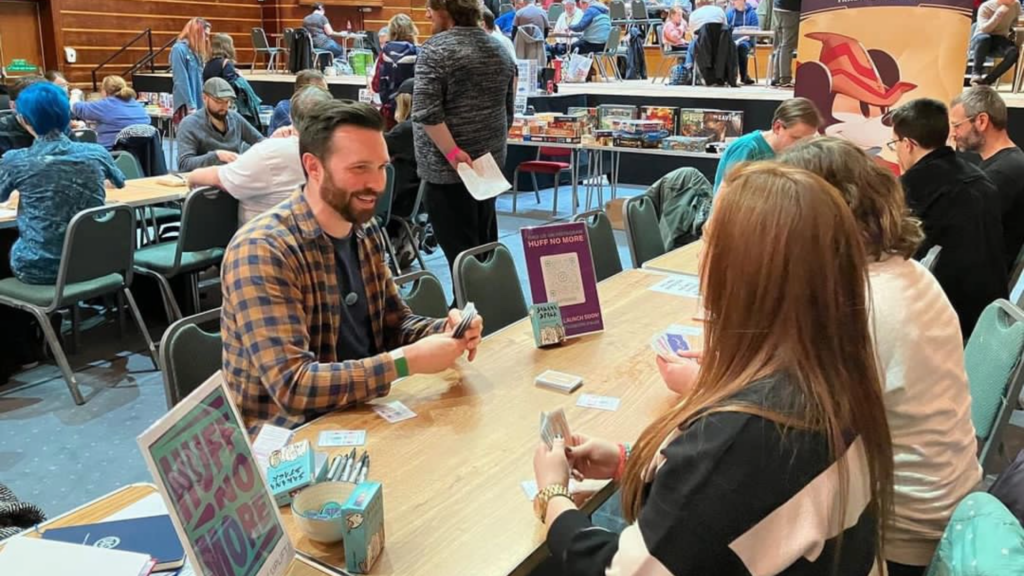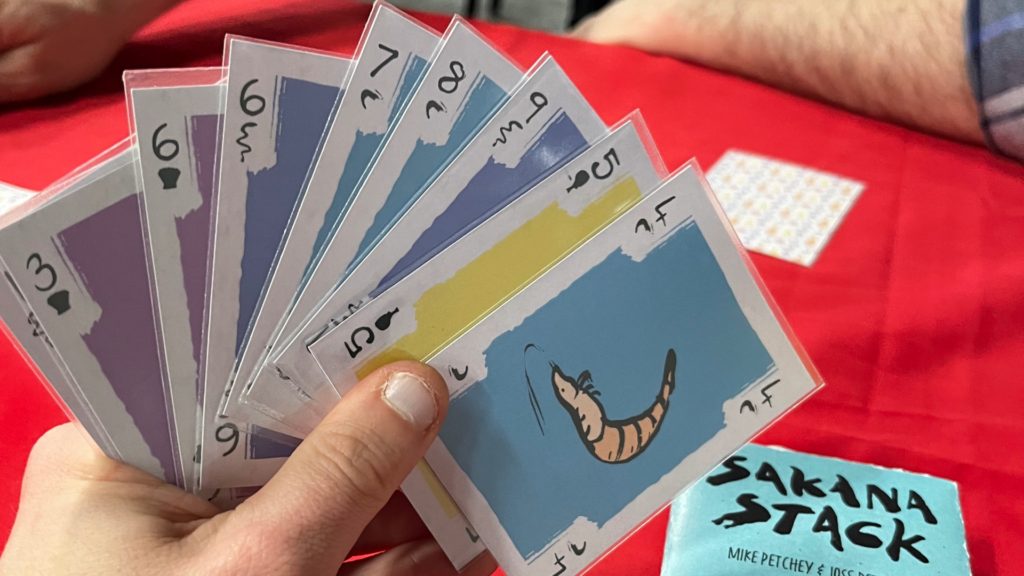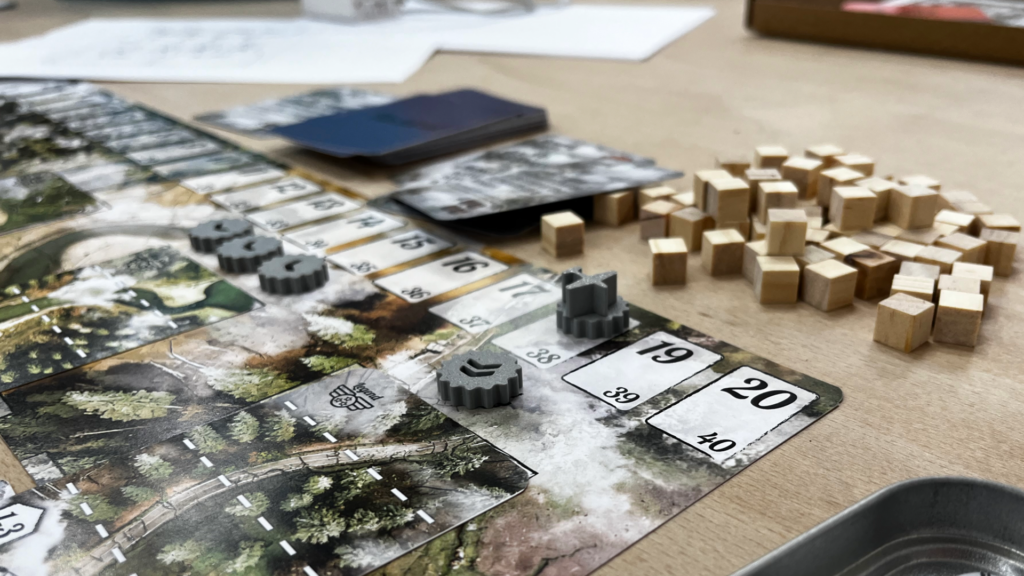
In the third of our ‘a conversation’ series, I catch up with Mike from Huff No More. I met Mike at Airecon in March 2024, he’s ace. We spent a little time play testing each other’s games and he gave me some great feedback on Drop Zone. You can find Mike on instagram @huffnomore and can check out the Kickstarter project page for his upcoming game Sakana Stack. You can find the Drop Zone Chocks Away project page here.
In this post we chat about our experience of having our games play tested.
Joe: Hey, Mike – let’s chat about all things playtesting. We’re both at similar stages in game development on Sakana Stack and on Drop Zone Chocks Away, so it would be good to share experiences and work out what playtesting means to us.
I’ll start with a question – what’s the best bit of feedback you’ve ever had on your game?
Mike: Hi Joe – great to be chatting with you! For me, the best feedback when playtesting is always when a flaw is pointed out in the game, which creates a negative experience for the player. Having the flaws pointed out has been key for me to understand a problem and find a way to solve it. Some of the early play tests of Sakana Stack found the game to be functional but lacking agency and the feedback pointed me to the areas of the game I needed to focus on improving.
How about you? And have you found a difference in playtesting with other designers vs gamers?
Joe: I think they offer two different but really important sides for feedback and development. Designers are keen to explore the mechanics of the game and can often give advice about what needs to change to step it up or notice fundamental challenges. I find this most useful earlier on in a game’s development. Playtesting with gamers can give a perspective on the game that gives me a sense of how people will play and enjoy the game. For me, this is helpful later in development, particularly after major kinks have been worked out.
Do you ever just ignore play testing feedback?
Mike: When I first started playtesting Sakana Stack I definitely took pretty much every piece of feedback and idea for changes on board and tried to implement them. I soon found out that a number of them just weren’t right for the game, and that I do not need to incorporate every suggestion; it’s down to me to establish what feedback is right for the game.

I’ve also had experience from playtesters where they simply did not like the genre of my game, so gave feedback trying to change the game to something they wanted. If you only like playing heavy Euros, then my lightweight shedding card game is probably not for you! So I’m a lot clearer now with people to make sure they are playtesting a game they are more likely to enjoy and provide relevant feedback.
I don’t need to incorporate every suggestion; it’s down to me to establish what feedback is right for the game.
Mike
Do you think it’s helpful for a playtester to try and ‘break’ a game?
Joe: There’s a place for breaking it – but I don’t think it’s at a late playtest table that should do that. If a playtester accidentally breaks it, that’s great; I can quickly analyse what’s happened, maybe tweak a rule or a bit of maths and fix it. But playing to break it, it’s tedious and not fun for any players. I want my playtesters to play it as though it’s a real game and see what they think. To be honest, I think that you, as a designer, should be the one pushing it to its limits.
How do you know when it’s ready? How much playtesting do you think you need?
Mike: When I first started out designing, I read the Kobold Guide to Board Game Design and there is an excellent diagram by Andrew Looney of Looney Labs. It shows three playtest stages as:
- Inner circle of friends
- Outer circle of friends
- Random strangers
In designing Sakana Stack, once I got to the point where I felt I had a pretty solid game from playtesting with my local game group, I signed up to the South London Playtest UK games group. It was fantastic to be able to meet and playtest with established indie publishers and experienced designers as the next step to see how close Sakana Stack was to being a complete game. I had some great feedback and made a few tweaks, then the game felt ready to unleash on the public!
So in January this year, I signed up to a full weekend of playtesting at Handycon. I was pretty terrified at this stage and really anxious – what if people really didn’t like my game! But happy to say, the experience was brilliant and great to get feedback from playtesters who treated the game as complete and wanted to play to have fun. With a number of playtesters asking when they could buy Sakana Stack, I knew the game was complete, and I had created a game which people wanted to buy and play – an incredible feeling of accomplishment!

So, the process of playtesting in my local games group, then an established playtest group, and then a public expo has worked incredibly well for me and is a formula I will follow for future games. Along with the mechanics, we had some brilliant feedback from playtesters at all stages to influence the artwork and graphic design of Sakana Stack.
How have you found playtesting has influenced how Drop Zone Chocks Away looks from an artwork and graphic design perspective?
Joe: The appearance of a game is a key part in how it plays – I\’m keen to develop a thematically immersive experience when playing the game. So, I’ve been paying close attention to feedback to see what might hint at changes to the form of the game. Drop Zone didn’t start out with a board; it was played entirely through cards. But as I watched people play, I realised that they were collecting rewards but had no way of knowing how another player was doing. This wasn’t verbal feedback, but what was gleaned from watching players play the game. I suppose that’s the other side of playtesting, what you, as the designer, see happen compared to what we want to see in your game. Are you getting the right vibes / feels?

The artwork has been more of a personal journey, and not something I’ve had any feedback on that would make me change its direction. I think I got really close to the feel I wanted from the artwork early on in the process, so I’d be actually quite unwilling to make big changes now!
Final question – I work with a design partner for Drop Zone. Sometimes we have opposing ideas for the game’s direction – have you got any experience of how you deal with competing ideas for development?
Mike: For the most part, my game design journey, in respect of mechanics at least, has largely been a solo effort, which suits me really well as I’m a bit of a control freak! But when we got into the artwork and graphic design stage, this is where my wife, Joss, joined the project. Sakana Stack started off as an abstract card game and then needed a theme. I had an initial idea of stacks of apples in a market and was quite set on this idea. We worked through a few ideas, and one that Joss pitched to me was the Tsukiji Fish Market in Japan, inspired by her own trip there in 2015. As the game is inspired by Japanese card games, this worked really well, and Joss started to bring together some initial artwork and styles. From these designs, I could really see the theme and mechanics work together and helped to bring the game to life.
The theme also inspired some later mechanics as I ventured out to wider playtesting groups, including a ‘Catch of the Day’ card, which very much fits the fish market theme. So that collaboration has definitely helped improve the game, not just in artwork and theme but also in mechanics. Now that I understand a lot more about the game design journey and the importance of theme, Joss has been involved at a much earlier stage of newer games we are working on. We don’t always agree on where the theme and mechanics should go, but usually find a point of compromise for the betterment of the game.
Joe: Thanks Mike, for spending this time with me, it’s been a really interesting conversation!
Want to follow Mike\’s progress in bringing Sakana Stack to a Kickstarter soon? You can find on instagram (@huffnomore), follow the Kickstarter or check out the Huff No More website. Huff No More are attending UKGE and can meet us in stand 2-896.



Pingback: Let’s get thematic: talking theme in table top games with The Board Game Wizard – What If Games
Pingback: Launching a successful kickstarter: conversation 3 with Mike from Huff No More – What If Games